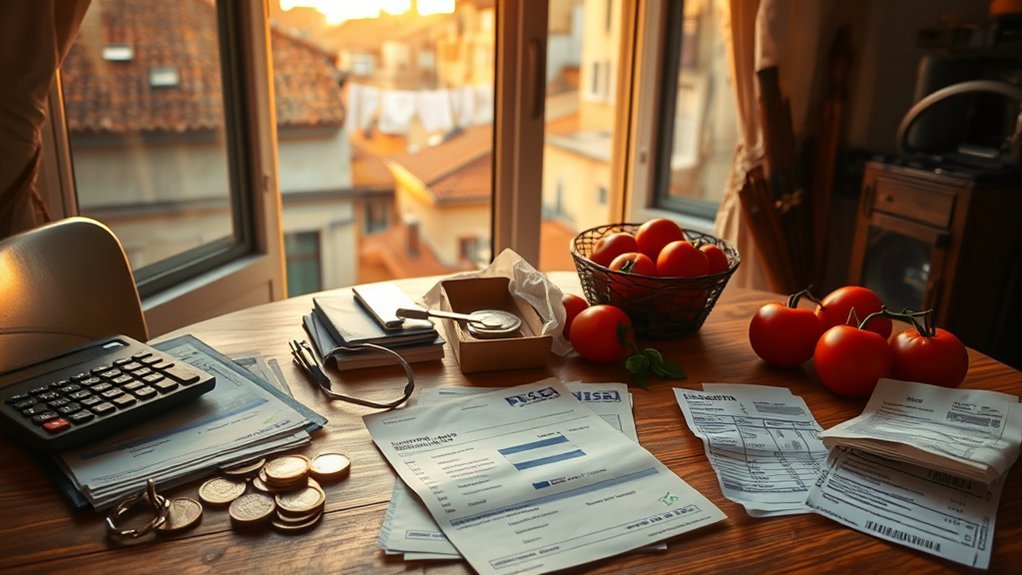Rome’s living costs are higher than you might expect: average net pay is about €1,800–€1,900, while a one‑bed in the centre runs €1,000–€1,300 and outside €650–€900. Utilities, internet and transport add €150–€300, groceries €250–€300 and eating out fills in the rest, so a comfortable single budget is nearer €2,200–€2,500. You’ll likely weigh shared housing, commuting or trimming extras to balance the books — keep going to see detailed breakdowns and tips.
Is Rome Expensive to Live In?

Wondering if Rome will stretch your budget? You’ll find the cost of living sits between cheaper Southern Italy and pricier Northern cities: locals manage on a monthly net salary of about €1,800–€1,900, but newcomers aiming for comfort generally want €2,200–€2,500+.
Wondering if Rome will stretch your budget? Expect mid-range costs — locals live on €1,800–€1,900, newcomers €2,200+.
Rent (1‑bedroom) can be the deal breaker — averages vary widely — so many students choose shared housing to keep monthly expenses near €1,200.
Outside rent, expect groceries of roughly €250–€300, an affordable public transport system (single ticket €1.50, monthly pass ≈ €35), and occasional mid-range restaurant meals — a three-course dinner for two in tourist areas is about €65.
Overall, non-rent monthly expenses often run €900–€1,100.
If you budget carefully and choose location and housing wisely, Rome feels reasonable; if you want city-centre convenience and private space, costs climb fast. The importance of careful budgeting cannot be overstated when managing living expenses in a city like Rome.
Monthly Housing Costs and Rent Breakdown
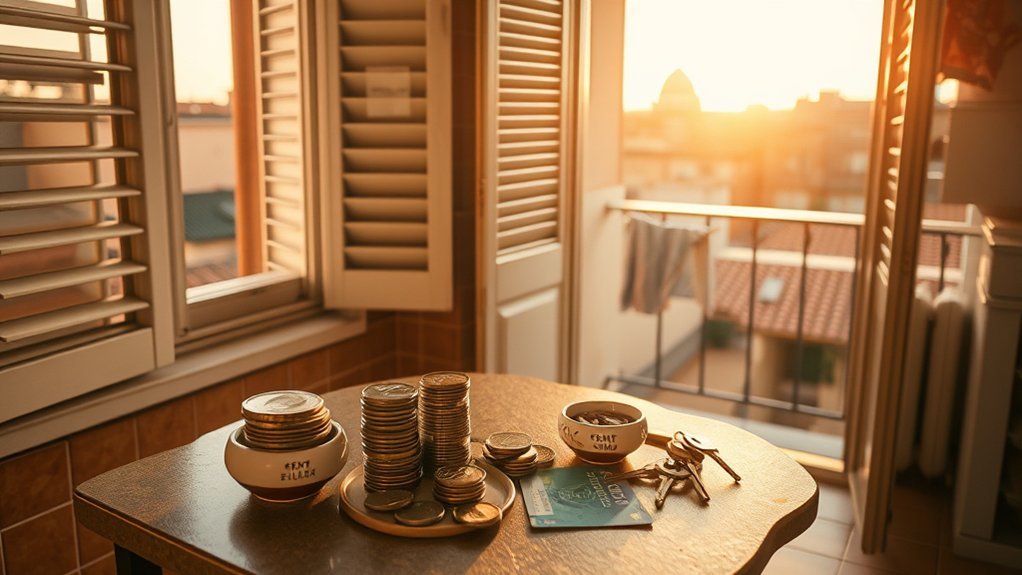
You’ll notice a clear split between city centre and outside centre prices. A 1-bedroom in the city centre averages €1,098–€1,255, while outside centre you’re looking at about €670–€789. Studios and small one-bedrooms commonly fall in the €900–€1,100 range, a middle ground if you want centrality without the highest costs.
If you’re sharing, a room averages around €645 and a 3-bedroom in the centre rents for roughly €2,095–€2,352 (outside centre €1,245–€1,479). Agency fees typically add 10–13% of the lease value upfront, so factor that into moving costs.
Rent tends to be the largest slice of your monthly income; comfortable living usually needs about €2,200–€2,500 or more. Prices shift by neighbourhood and have been affected by tourism and service-sector changes, so consider peripheral residential areas for savings. Additionally, understanding initial startup costs for housing can help you budget more effectively when moving to a new city.
Utilities, Internet and Home Services
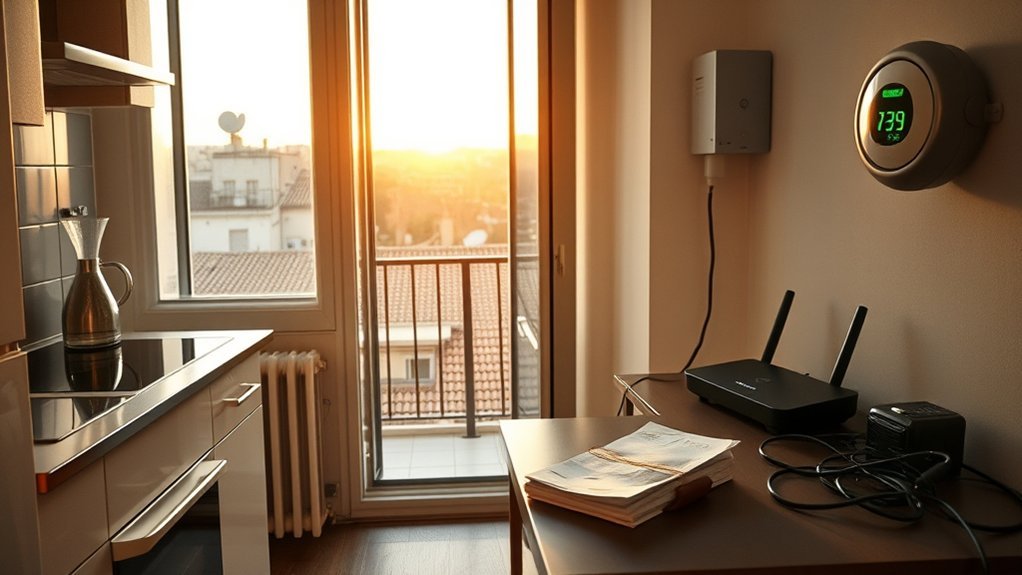
When you add up lights, heat, water and garbage, expect basic utilities for an average apartment to run roughly €150–€220 a month (smaller flats can be as low as €60–€120), with bills spiking in winter if you rely on gas or electric heating.
You’ll notice monthly costs vary with apartment size and habits — a 45 m² flat can be €60–€120, while an 85 m² place often hits €80–€220 depending on heating.
Internet at 60 Mbps+ usually costs €25–€35, and mobile plans with ~10 GB run about €6–€15; combined Internet plus mobile averages €35–€50 including occasional setup or modem fees.
You can hire housekeeping for roughly €8–€12 per hour to keep things tidy.
Don’t forget annual home insurance — often €250–€300 and sometimes including earthquake cover. Regular maintenance, similar to preventative measures for school computers, can help minimize unexpected costs.
Grocery Prices and Food Budget
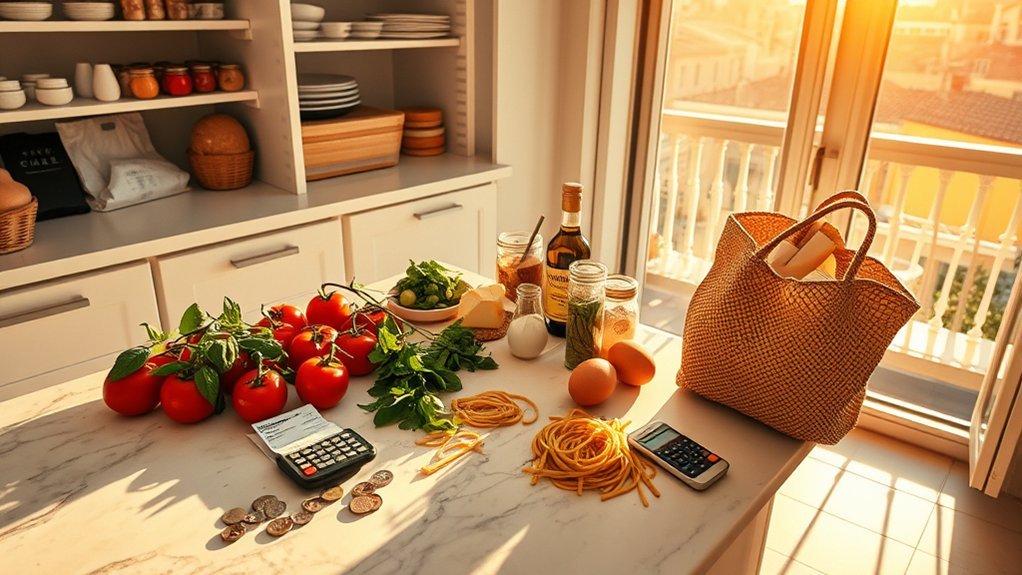
You’ll find grocery shopping in Rome keeps a lot of your monthly food bill reasonable — expect about €250–€300 if you mostly cook at home. You’ll notice supermarkets are efficient and about 14% cheaper than Milan, so doing a weekly shop saves time and cash.
Staples like milk (€1–€1.53/L), a dozen eggs (€3.80–€4.50), and chicken fillets (€4.55–€10.10/kg) sit within expected ranges, while beef fillet runs higher near €17/kg. Fresh produce is friendly to your wallet: tomatoes €1–€3/kg, potatoes €1/kg, apples ≈€1.05/lb and bananas ≈€0.94/lb.
A mid-range bottle of wine in-store averages €5, and domestic 0.5L beer about €1.64, so grabbing drinks for home is affordable. Bottled water (1.5L) costs around €0.39–€0.43. Regular maintenance tips can help you manage your overall food budget effectively, ensuring you make the most of your grocery shopping.
If you mostly cook, these groceries will cover your monthly needs; eating out will push your food budget up considerably, so plan meals to keep costs steady.
Eating Out, Cafés and Nightlife Costs
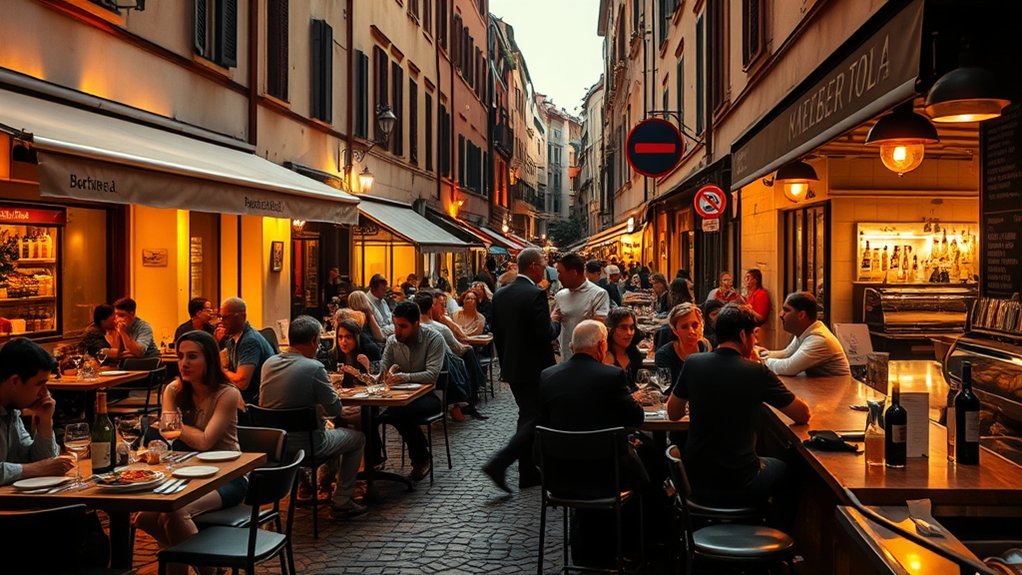
A meal out in Rome can feel like a ritual: a casual lunch will usually set you back about €16 per person, while a three-course dinner for two in a mid-range, touristy spot averages around €65 (local/basic dinners nearer €36).
You’ll find eating out varies by neighborhood: tourist hubs push prices up, residential streets keep them friendlier.
Cafés serve cappuccino for €1.20–€2.50, so grabbing coffee before wandering is cheap and charming. If you opt for a McMeal (fast food), expect about €7–€8.
Nightlife is lively and varied: an aperitivo or cocktail runs €10–€15, a beer (0.5 L) in a bar is roughly €5, while supermarket bottled beer is closer to €1.60.
An evening out—dinner plus drinks—for two often totals €40–€70, depending on location and tastes. Cinema tickets cost about €16–€20 for two. It’s also worth noting that regular inspections of your air conditioning system can help prevent future issues while enjoying your time in the city.
Transportation and Commuting Expenses
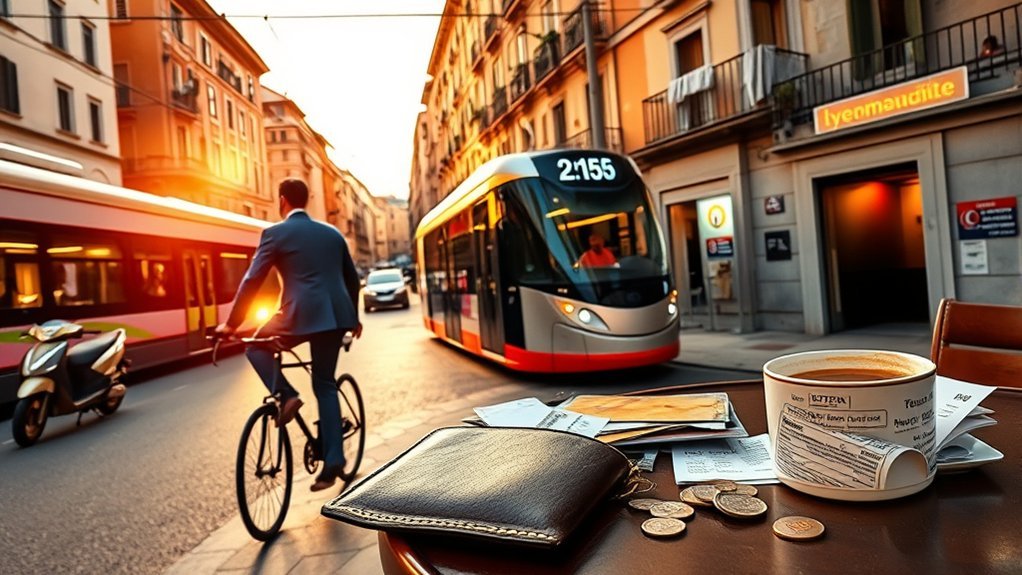
Because Rome’s public transport is extensive but often crowded and prone to delays, you’ll usually find hopping on buses, trams or the metro the most practical and economical way to get around — a single ticket costs €1.50 (valid for about 75–90 minutes), a monthly pass runs roughly €35, and an annual pass is near €250. You’ll rely on public transportation for most commutes, but budget extra time and watch for pickpockets in tourist areas.
| Item | Typical cost |
|---|---|
| One-way ticket | €1.50 |
| Monthly pass | €35 |
| Annual pass | €250 |
| Taxi fares (start/km) | €4–€5 start, €1.10–€1.50/km |
| Fuel per litre | €1.45–€1.80 |
If you drive, factor parking and potential ZTL fines into monthly budgets, plus utilities (heating/garbage) which add €150–€220. Taxis can be useful late at night but are costly; petrol prices make daily car commuting less practical than a monthly pass. Additionally, be mindful of regular maintenance for your vehicle to avoid unexpected repair costs related to your exhaust system.
Entertainment, Health and Personal Spending
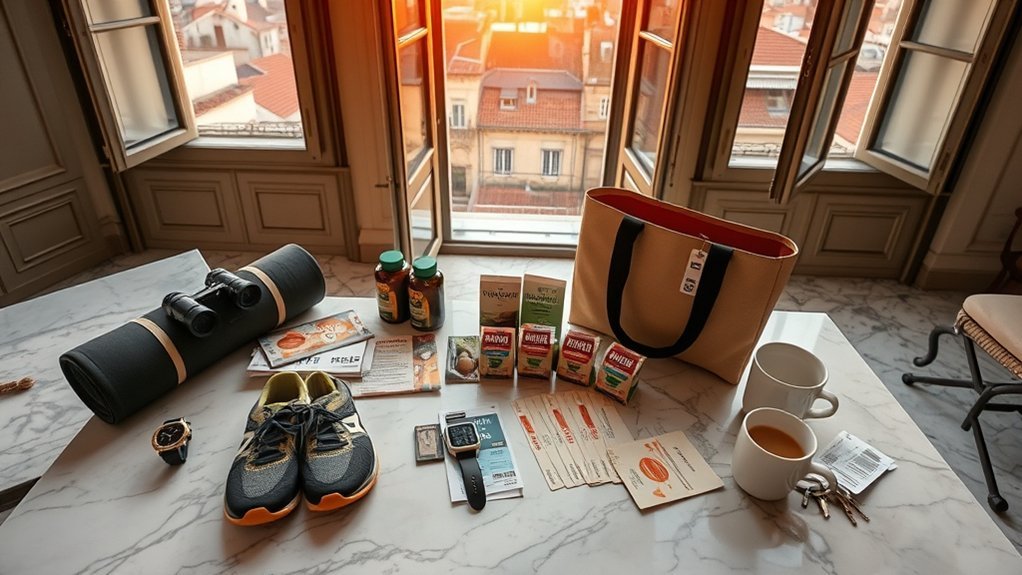
When you head out in Rome you’ll notice eating and nightlife can be surprisingly affordable or easy to overspend—dinner for two in a mid-range place runs about €50–€70, cinema tickets are €8–€12, and theatre or concert seats commonly cost around €36 each.
For staying well, routine private doctor visits typically cost €70–€150 and an annual outlay for prescriptions and incidentals can add a few hundred euros.
Personal care like a men’s haircut (€18), spa days (€30+), and fitness or court rentals (€10–€25/hr) round out what you should budget. Additionally, understanding typical range of costs for various services can help you plan your finances better.
Nightlife & Dining Costs
Often you’ll find Rome’s evenings are as lively as its mornings, but your wallet will notice the difference: a three-course tourist meal for two runs about €65 while a simple local dinner is nearer €36.
You’ll weigh restaurant prices when planning nights out — a three-course dinner can add up, while lunch (working-day) options average €12–€16 per person and inexpensive meals hover around €15.
For drinks, a beer (0.5 liter) is about €5, cocktails near €11, and a cappuccino ranges €1.20–€2.50, so bar hops or café stops change totals quickly.
Entertainment like cinema or theatre and museum entry further affect evenings, so you’ll balance dining and nightlife choices to fit your budget.
Healthcare & Personal Care
If you want to keep healthy and entertained in Rome without surprises, plan for a mix of regular expenses and occasional splurges: private doctor visits run about €70–€150, basic over‑the‑counter meds cost around €7, and a course of common antibiotics is roughly €10, while a private insurance policy for two averages near €748 a year. You’ll balance monthly gym/fitness club fees (€40–€70), occasional private dental or specialist visits, and personal and entertainment spending that pushes a single person’s non‑rent budget toward €900–€1,100. A men’s haircut in residential areas is about €18. Decide where to splurge — private health insurance cushions costs, while pay‑as‑you‑go care keeps monthly bills lower.
| Item | Typical Cost | Notes |
|---|---|---|
| private doctor | €70–€150 | short visits |
| monthly gym/fitness club | €40–€70 | budget to upscale |
| over‑the‑counter cold medicine | €7 | common meds |
| medical antibiotics | €10 | full course |
Salaries, Taxes and Financial Considerations

In Rome you’ll notice take‑home pay often sits around €1,800–€1,922 per month, though some datasets report averages nearer €1,386–€1,922.
After taxes and social contributions your net salary can feel tight compared with the ~€2,200–€2,500+ monthly income many single residents consider comfortable, so deductions and benefits matter. Understanding the typical tax rates can help residents better manage their finances and plan their budgets effectively.
We’ll look at typical tax rates, common payroll deductions and how they affect what you actually have left for rent, bills and savings.
Average Net Salaries
While average net salaries in Rome hover around €1,800–€1,922 per month, you’ll quickly notice that this income often won’t stretch far once rent and basic bills are factored in. If you’re a person living on that average net salary, rent 1-bedroom city-centre eats a huge slice of your wages; Outside (bedroom) rent helps but still tightens budgets. Add utilities per month and a Monthly public transport pass and disposable income shrinks. Even mortgage interest rate variability means buying may not free you. You’re juggling choices: smaller flat, shared housing, or commuting farther out. Below is a simple table that mirrors the emotional trade-offs you face.
| Cost item | Typical | Emotional hit |
|---|---|---|
| Rent 1-bedroom city-centre | €1,000–€1,300 | High |
| Outside (bedroom) rent | €650–€900 | Medium |
| Utilities & transport | €95–€235 | Noticeable |
Tax Rates & Deductions
Rent eats a big slice of your paycheck, so it helps to look at what else is taken out before you see net pay: Italy’s personal income tax (IRPEF) is progressive — roughly 23% up to €15,000, 25% to €28,000, 35% to €50,000 and 43% above €50,000 — and you’ll also face regional and municipal surtaxes (usually about 0.7–3%) plus employee social security (INPS) contributions of roughly 9–10%.
You’ll notice gross pay must cover IRPEF, Social security contributions (INPS) and surtaxes before you get a typical net monthly salary of around €1,800–€1,920 in Rome. Tax deductions and credits can trim liabilities — dependent family members, deductible employment costs, mortgage interest deduction, healthcare (SSN) or private premiums matter.
Practical tips:
- Check withholding to match expected IRPEF.
- Track deductible expenses monthly.
- Register for SSN if resident.
- Consider tax credits for family.
Frequently Asked Questions
How Much Does It Cost to Live in Rome per Month?
You’ll typically need €1,200–€2,700+ monthly, depending on neighborhood differences; include transport passes, monthly utilities, groceries budget, health insurance, co working costs, entertainment expenses, and seasonal variations when planning your spending.
Can You Live in Italy on $3,000 a Month?
Yes — you can live comfortably on $3,000/month, but juxtaposing comfort with surprise, you’ll need budget planning, consider visa implications, healthcare access, tax considerations, language learning, remote work, cultural adaptation, and maintain emergency savings.
Is It Expensive for an American to Live in Rome?
Not really — you’ll find Rome affordable for Americans with higher U.S. wages. Consider cost comparison, visa considerations, cultural adjustment, healthcare access, language barriers, banking setup, dining etiquette, and transportation costs as you settle in and adapt.
Is It Cheaper to Live in Italy or the USA?
Balance scales tip: you’ll usually find Italy cheaper overall, thanks to grocery prices, public transportation, and healthcare access, but currency exchange, taxation differences, job opportunities, visa requirements, and cultural adjustment can sway your choice.
Conclusion
Living in Rome feels richly textured — cobblestones, espresso stops, and sunlit piazzas — and it’s not as outrageously expensive as you might fear if you plan well. You’ll pay more for central housing and convenience, but suburbs and shared flats cut costs without killing your experience. Don’t assume low salaries ruin life here; many balance wages, tips, and savings smartly. If you’re flexible, Rome gives culture, food, and transport value that often outweighs the extra euros.

